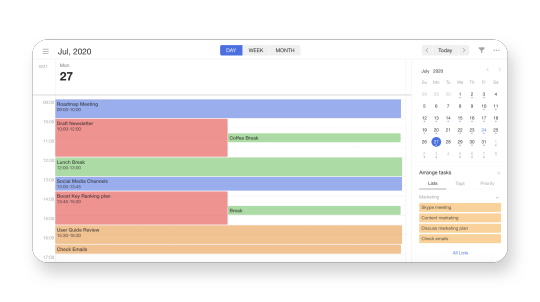
What is Time Blocking
You might instantly recall the Lego blocks that we used to build a house when we were kids. Similarly, if we split 24 hours/1440 minutes of a day into blocks, how we spend the time is how we pile up these blocks in order the house to be built.
Time Blocking is a time management method that helps us get more done in the finite time by cutting a day into many chunks and each chunk is dedicated to a certain task. Some of the world’s most productive people, from Elon Musk to Bill Gates to Cal Newport (Author of Deep Work) have combined their to-do lists with this important method: Time Blocking.
A Russian entomologist Alexander Aleksandrovich Lyubishchev, kept recording the expenditure of his time, for 56 years in a row, in order to stay in control of his time. This comes with higher necessity in today’s society since 24-hour-a-day remains unchanged, while daily information explodes in the modern workplace.

How Time Blocking works
From the face value, this technique seems just a walk in the park. In what way can it really benefit us?
* It reduces context switching and mental energy loss
Time blocking is closely linked with task batching, which means similar tasks can be grouped together and distributed to time chunks. There are mainly two types of tasks at work: Deep and shallow. Deep tasks such as coding, designing, and drafting a marketing plan, usually require intensive attention and deep thinking, while shallow tasks are comparatively low-value tasks like emails, team chats and phone calls.
Setting a time frame for shallow work can prevent you from spending too much time on it and save mental spaces for other higher-value tasks. Combining time blocking and task batching also avoids frequent context-switching and helps minimize your cognitive burden caused by goal-changing.
* It helps lock your focus and reduce anxiety
Doing one task at a time can lock your focus and keep it intact, compared with splitting your attention across multiple tasks. With all mental resources invested in a single task, it can avoid getting distracted by miscellanies. With all tasks planned out alongside the day, the anxiety level is also lower because you can easily gain the control power over your workload.
* It helps keep track of your time expenditure
When you get used to scheduling your day into set and controlled units, your own productivity pattern will form. For one thing, competitive daily/weekly tasks can be quickly arranged. For another, you’ll know the average time spent on certain tasks, which then helps you make realistic plans on time allocation. Therefore, time blocking lets you track your time-spending and further reflect on it for higher efficiency.

Is Time Blocking effective for everyone?
Well, the fact is there is never a one-fits-all solution. Time Blocking might be infeasible for reactive workers, e.g. customer support specialists, whose work is basically based on in-time situations and thus cannot be estimated.
However, blocking time off has an instant effect on those who have a short-term goal, no matter if it’s an important exam or a job application, because they need to use their time wisely in a short period to maximize output. In another case, if you’re a fresh graduate who just joined a new company, then maybe the awareness and skills of time management are what you need, to avoid being trapped into the “keeping-busy fallacy” where workload keeps piling up but productivity keeps running low. Time Blocking also works for someone who can get a sense of accomplishment and stability from a well-scheduled daily life and who’d wish to continuously look back on his/her performance.

Some misuses of Time Blocking
Like what’s being said, even though time blocking is a simple concept from the surface, it can still be misused and taken to extremes. There are mainly five cases that cannot be considered as an appropriate adoption of time blocking.
* Keep every minute on the regiment, and make 24 hours fully stuffed.
* Too strict to the schedule and any changes or flexibility are not allowed.
* Too optimistic about the estimated time arranged for a task.
* No any loosening-up activities scheduled between blocks.
* Sequent time chunks filled with all deep work, or vice versa.

Step-by-step guide to use Time Blocking at TickTick
* Creating a to-do list
Creating different lists for projects or different parts of your work, and writing down what you need to do is all for the start. Don’t forget to set Tag or Priority for these tasks, because this is important for quick sorting and grouping in later arrangement.
Tip: Make sure to distinguish different Lists and Tags with color coding, because tasks will then show in the calendar in the form of color blocks, based on three options: the color of Tag, List, or Priority.
* Arranging Tasks in the Calendar
After going to Calendar in TickTick, you can switch the view to Today (also for tomorrow/three-day/week/month). Tap “Arrange Tasks” and all tasks you’ve created before can be filtered by Lists, Tags or Priority. Here you can add any tasks into any time blocks simply via drag n’ drop. The space of each time box is adjustable and the minimum size is 30 minutes. The sequence of blocks is also changeable if you’d like to fill one time slot with multiple tasks for example, or keep a good balance between shallow and deep tasks.
After this step, you’ll be able to see a completed time-boxed schedule with tasks planned out for Today.
Tip: If you’re using other calendar tools, you can import your data into the TickTick calendar too.

* Starting to focus with a Pomo Timer/Stopwatch
Now, it’s time to start working! Opening a task from your Time Block 1 and starting to focus with the Pomo timer on in TickTick. Pomo helps enhance your focus and also keep a work-rest balance. But if it’s a new task and you wish to test out how much time it’ll cost, then Stopwatch instead of Pomo should come in use to count up the time. Therefore, next time when scheduling, you’ll be able to make a fair evaluation on time allowance for this task.

* Tip1: Saving repetitive tasks as Templates
An easier and faster way to arrange a repetitive task is from the Template. Instead of repeating the process of creating the same task each time, a daily task such as team meeting, can be saved as a Template. With this, the task can be added to your “Today” List in just seconds.
* Tip2: Have you tried “Plan Your Day”?
Another helpful feature for a quick schedule is “Plan Your Day”. On the right top corner of your “Today” List, you can find a double circle shaped button, and from there all your today’s tasks and overdue tasks can be arranged with just a few steps away.



